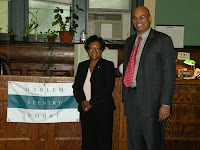Time: 10:00 am
How a coalition of stakeholders is reducing recidivism and enhancing public safety in Upper Manhattan
The Harlem Community Justice Center's Reentry Services are located in East Harlem
The choir started off the celebration this year at the Reentry Court Graduation
During the summer, we host a block party and celebration for Reentry clients and their families
Young man thanks his Parole Officer for keeping him on track
Families join to celebrate the accomplishments of graduates
 Family Justice in partnership with the NYU Wagner Graduate School for Public Service is hosting a roundtable discussion on health care and criminal justice involvement. The discussion will address the current state of health care for people leaving prisons and jails and potential strategies for improving health care delivery. The event is open to students, professionals, and the public. It will take place at:
Family Justice in partnership with the NYU Wagner Graduate School for Public Service is hosting a roundtable discussion on health care and criminal justice involvement. The discussion will address the current state of health care for people leaving prisons and jails and potential strategies for improving health care delivery. The event is open to students, professionals, and the public. It will take place at:

Re-Entry Coalition Helps Ex-Prisoners
Lynden Tribune, Washington State
http://www.lyndentribune.com/node/4540
Women Who've Done Time Guide Those Newly Released
Arizona Daily Star, Arizona
http://www.zwire.com/site/news.cfm?newsid=20331982&BRD=1817&PAG=461&dept_id=222087&rfi=6



 Reentry projects in Singapore? Yes, and how much more advanced they are than our own public outreach efforts!
Reentry projects in Singapore? Yes, and how much more advanced they are than our own public outreach efforts!We can take example from Singapore in their success raising public awareness of the challenges of reentry and creating large-scale public support for the idea of "second chances." We'd be curious to hear about other examples, so please pass them along!
 Check out this article in today's Gotham Gazette about reentry efforts uptown. In addition to highlighting the Upper Manhattan Reentry Task Force and the Harlem Parole Reentry Court, the articles discusses good work at Exodus Transitional Community, The Fortune Society, and the NYS Division of Parole.
Check out this article in today's Gotham Gazette about reentry efforts uptown. In addition to highlighting the Upper Manhattan Reentry Task Force and the Harlem Parole Reentry Court, the articles discusses good work at Exodus Transitional Community, The Fortune Society, and the NYS Division of Parole.
 This weekend, Rethinking Reentry staff had a chance to visit the Museum of Modern Art and discovered some reentry maps hanging on the walls of the Architecture and Design wing.
This weekend, Rethinking Reentry staff had a chance to visit the Museum of Modern Art and discovered some reentry maps hanging on the walls of the Architecture and Design wing.
 The Youth Justice Board, a group of city teens, has issued 10 proposals for how the city could approve its alternative detention programs for young people charged with crimes. The group, which was organized by the Center for Court Innovation and spent a year studying the issue, recommends creating temporary shelters for teens who cannot go back home after their arrests, screening programs participants for possible mental health problems, and better links between the schools and the alternative programs.
The Youth Justice Board, a group of city teens, has issued 10 proposals for how the city could approve its alternative detention programs for young people charged with crimes. The group, which was organized by the Center for Court Innovation and spent a year studying the issue, recommends creating temporary shelters for teens who cannot go back home after their arrests, screening programs participants for possible mental health problems, and better links between the schools and the alternative programs.
 From our partners at the Upper Manhattan Workforce 1 Career Center:
From our partners at the Upper Manhattan Workforce 1 Career Center:
 Our colleagues at the Center for Court Innovation had an interesting conversation about failure and policing innovations with R. Gil Kerlikowske, who was selected by President Barack Obama to lead the Office of National Drug Control Policy. Prior to being named drug czar, he was the chief of the Seattle Police Department. This article seems particularly relevant now, as the New York Police Department is confronting its own recent training and diversity failures in the wake of Officer Omar Edwards' death.
Our colleagues at the Center for Court Innovation had an interesting conversation about failure and policing innovations with R. Gil Kerlikowske, who was selected by President Barack Obama to lead the Office of National Drug Control Policy. Prior to being named drug czar, he was the chief of the Seattle Police Department. This article seems particularly relevant now, as the New York Police Department is confronting its own recent training and diversity failures in the wake of Officer Omar Edwards' death.